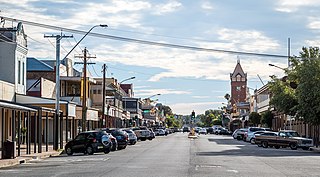
Broken Hill is an inland mining city in the far west of outback New South Wales, Australia. It is near the border with South Australia on the crossing of the Barrier Highway (A32) and the Silver City Highway (B79), in the Barrier Range. It is 315 m (1,033 ft) above sea level, with a hot desert climate, and an average rainfall of 235 mm (9 in). The closest major city is Adelaide, the capital of South Australia, which is more than 500 km (311 mi) to the southwest and linked via route A32.
The miners' strike of 1984–1985 was a major industrial action within the British coal industry in an attempt to prevent colliery closures. It was led by Arthur Scargill of the National Union of Mineworkers (NUM) against the National Coal Board (NCB), a government agency. Opposition to the strike was led by the Conservative government of the Prime Minister, Margaret Thatcher, who wanted to reduce the power of the trade unions.

The Ludlow Massacre was a mass killing perpetrated by anti-striker militia during the Colorado Coalfield War. Soldiers from the Colorado National Guard and private guards employed by Colorado Fuel and Iron Company (CF&I) attacked a tent colony of roughly 1,200 striking coal miners and their families in Ludlow, Colorado, on April 20, 1914. Approximately 21 people, including miners' wives and children, were killed. John D. Rockefeller Jr., a part-owner of CF&I who had recently appeared before a United States congressional hearing on the strikes, was widely blamed for having orchestrated the massacre.
Union violence is violence committed by unions or union members during labor disputes. When union violence has occurred, it has frequently been in the context of industrial unrest. Violence has ranged from isolated acts by individuals to wider campaigns of organized violence aimed at furthering union goals within an industrial dispute.
The Australian labour movement began in the early 19th century and since the late 19th century has included industrial and political wings. Trade unions in Australia may be organised on the basis of craft unionism, general unionism, or industrial unionism. Almost all unions in Australia are affiliated with the Australian Council of Trade Unions (ACTU), many of which have undergone a significant process of amalgamations, especially in the late 1980s and early 1990s. The leadership and membership of unions hold and have at other times held a wide range of political views, including communist, socialist and right-wing views.

Burra is a pastoral centre and historic tourist town in the mid-north of South Australia. It lies east of the Clare Valley in the Bald Hills range, part of the northern Mount Lofty Ranges, and on Burra Creek. The town began as a single company mining township that, by 1851, was a set of townships collectively known as "The Burra". The Burra mines supplied 89% of South Australia's and 5% of the world's copper for 15 years, and the settlement has been credited with saving the economy of the struggling new colony of South Australia. The Burra Burra Copper Mine was established in 1848 mining the copper deposit discovered in 1845. Miners and townspeople migrated to Burra primarily from Cornwall, Wales, Scotland and Germany. The mine first closed in 1877, briefly opened again early in the 20th century and for a last time from 1970 to 1981.
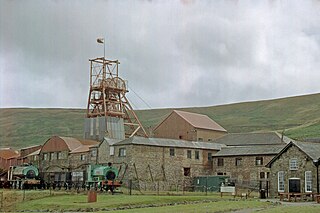
Big Pit National Coal Museum is an industrial heritage museum in Blaenavon, Torfaen, Wales. A working coal mine from 1880 to 1980, it was opened to the public in 1983 under the auspices of the National Museum of Wales. The site is dedicated to operational preservation of the Welsh heritage of coal mining, which took place during the Industrial Revolution.
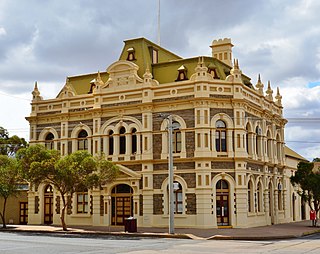
The Barrier Industrial Council is the trades and labour council for the isolated mining town of Broken Hill, New South Wales, Australia. It was formed in 1923 by eighteen unions and grew to be one of the most influential forces in the politics of the city of Broken Hill in the late twentieth century. It also owns Broken Hill's only newspaper, the "Barrier Daily Truth".
The Cape Breton coal strike of 1981 was a strike by coal miners who were members of the United Mine Workers of America against the Cape Breton Development Corporation (DEVCO) of Cape Breton Island, Nova Scotia, Canada. The strike, which was bitter and violent, began in the middle of July 1981, and ended in early October of that year.
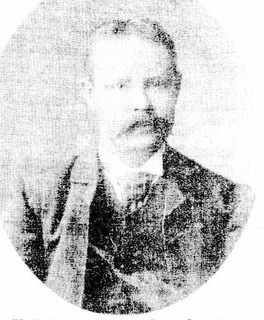
The 1892 Broken Hill miners' strike was a sixteen-week strike which was one of four major strikes that took place between 1889 and 1920 in Broken Hill, NSW, Australia.
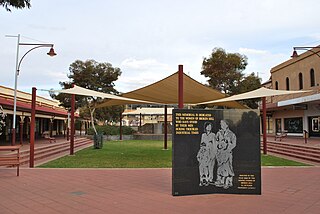
The Women's Brigade was a labour protest organisation for women formed during the first of several strikes to occur in the mining town of Broken Hill, NSW, Australia between 1889–1920.

People have worked as 'coal miners for centuries, but they became increasingly important during the Industrial revolution when coal was burnt on a large scale to fuel stationery and locomotive engines and heat buildings. Owing to coal's strategic role as a primary fuel, coal miners have figured strongly in labor and political movements since that time. After the late 19th century coal miners in many countries were a frequent presence in industrial disputes with both the management and government. Coal miners' politics, while complex, have occasionally been radical, with a frequent leaning towards far-left political views. A number of far-left political movements have had the support of both coal miners themselves and their trade unions, particularly in Great Britain. In France, on the other hand, coal miners have been much more conservative. In India, Coal Miners Day is celebrated on May 4.
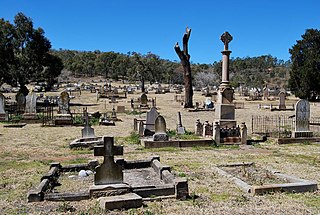
Mount Morgan Cemetery is a heritage-listed cemetery at East Street, Mount Morgan, Rockhampton Region, Queensland, Australia. It was established in 1886. It was added to the Queensland Heritage Register on 21 October 1992.

Collinsville Cemetery is a heritage-listed cemetery at Collinsville-Scottville Road, Collinsville, Whitsunday Region, Queensland, Australia. It was built from 1927 onwards. It is also known as Collinsville-Scottville Cemetery. It was added to the Queensland Heritage Register on 18 September 2009.

Lilyvale Stand Monument is a heritage-listed memorial at Lilyvale Road, Crinum, Central Highlands Region, Queensland, Australia. It was built in 1998. It was added to the Queensland Heritage Register on 2 April 2004.

R v Commonwealth Court of Conciliation and Arbitration; Ex parte BHP, was an early decision of the High Court of Australia concerning the jurisdiction of the Commonwealth Court of Conciliation and Arbitration in which the High Court controversially, granted prohibition against the Arbitration Court to prevent it from enforcing aspects of an industrial award. The High Court held that the Arbitration Court had gone beyond settling the dispute that had been submitted to it and in doing so had made a jurisdictional error.
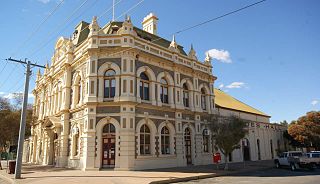
The Broken Hill Trades Hall is a heritage-listed trades hall at 34 Sulphide Street, Broken Hill, City of Broken Hill, New South Wales, Australia. It was designed by Tom Jackson and built from 1898 to 1905. The property is owned by the Trades Hall Trust. It was added to the New South Wales State Heritage Register on 2 April 1999.

Catherine Hill Bay Cultural Precinct is a heritage-listed company town at Catherine Hill Bay, City of Lake Macquarie, New South Wales, Australia. It was added to the New South Wales State Heritage Register on 5 November 2010.

Samuel Byrne was an Australian naïve painter and folk historian who visually chronicled the rise of Broken Hill, from its frontier days right through to the establishment of a modern city. Without any formal training, Byrne took to painting when he was in his seventies after retiring from a lifetime working on Broken Hill's mines. His painstakingly detailed panoramas of Broken Hill's township were discovered by Leonard French, who brought him to the attention of Sydney and Melbourne's art connoisseurs. Byrne is best known for painting his memories of subjects that held a personal fascination for him; Broken Hill's rabbit plagues, Sturt's desert peas, dust storms, industrial riots, and pioneering mining scenes. As a trade unionist and having first hand experience of the harsh mine conditions, his works are often imbued with a working-class consciousness and show a deep sensitivity to the plight of the victimised. Although the media often compared him to Grandma Moses, as James Gleeson writes, Byrne "paints in a manner that is so consistent that we are obliged to acknowledge it as a personal style."
Anne Harper is a British community organiser, activist and co-founder of the National Women Against Pit Closures (NWAPC) movement from Barnsley, South Yorkshire. She was politically active during the 1984-85 miners' strike as an activist, community organiser and wife of the then President of the National Union of Mineworkers (NUM), Arthur Scargill. The couple divorced in 2001.















